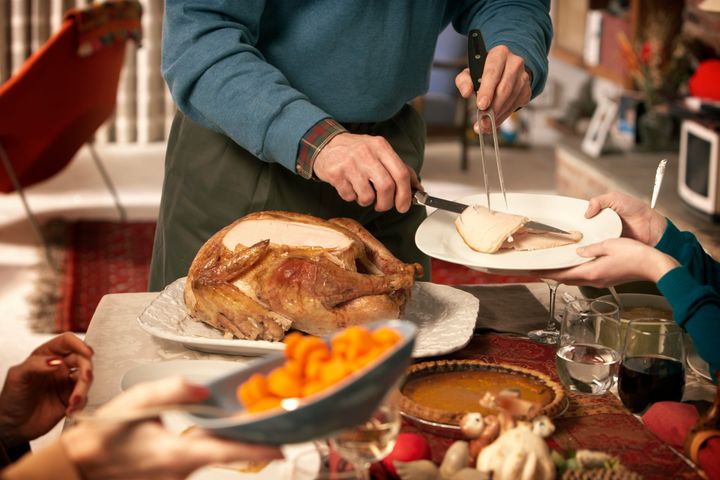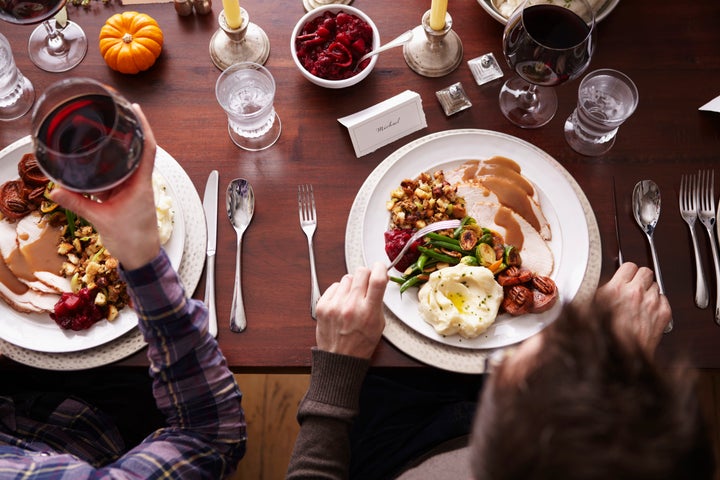
If you’re hosting Thanksgiving this year, your mind is likely occupied with recipe research, house cleaning, family travel logistics and kitchen prep. But before you embark on a home-cooked Thanksgiving meal, there’s one very important thing you need to do: Make a recycling plan.
People often recycle incorrectly or fail to recycle at all, said Rebecca Benner, the director of science and strategy at The Nature Conservancy in New York. And Thanksgiving certainly presents the opportunity to create a lot of waste.
“The consequence of not recycling is that your waste ends up in landfills and produces toxic gases that harm the planet and lead to more climate change, which in turn has huge numbers of consequences,” said Benner. “It’s also really important to check with your local agency to see what they do and don’t recycle because you can contaminate an entire batch of recycling if you stick something in there that can’t be recycled.”
Look Up Your Community Guidelines
Before Thursday, look up your community’s recycling information. Not every municipality accepts the same recyclables, so it’s important to learn which items are accepted in your area. You can also find options for responsibly disposing of less common types of materials, though they may require driving to a specific location or coordinating a pickup.
The Keep America Beautiful campaign website includes a guide to what types of items are recyclable, along with helpful “myth buster” columns to separate sustainability fact from fiction. It’s also helpful to learn about different types of plastic with charts that break down the numbering system.
Some things to keep in mind around Thanksgiving include the importance of scrubbing food grease off aluminum pans and tins, removing wood or plastic accents on otherwise recyclable items and repurposing things that can’t be recycled like stained napkins and tablecloths. If after consulting online resources, you’re still not sure about what you can and cannot recycle, try calling your local recycling service ahead of Thanksgiving Day.
“It’s easier to do recycling the wrong way than it is to do it the right way,” Benner said, noting that recycling companies often change the rules around what is and isn’t accepted and don’t always communicate these changes very well. “Sometimes, it just takes a lot of conscientious research or contacting your local recycling company to make sure that you’re actually putting in the things that they take.”

Of course, you can take further steps toward having a sustainable Thanksgiving. “Obviously the best thing you could do is minimize the number of things you even need to recycle because recycling still takes energy,” said Benner.
Beyond Recycling
One positive step is using real plates, cutlery, cookware and serving platters. Investing in a large roasting pan that you don’t have to throw away is a great way to save yourself from having to buy new disposable ones, especially if you think you might host Thanksgiving again in the future or want to roast a chicken at some point during the year.
“As a working mom who has lots of people over for Thanksgiving, the idea of washing my dishes is sometimes more than I can handle, but I always try to use reusable dishes,” Benner noted. “And if you have a dishwasher, even better because that actually saves on water as opposed to hand-washing the dishes.”
If you do end up using disposable aluminum pans, you can wash them and try to reuse them again or even convert them to foil covers for leftovers (while following health guidelines of course).
If you can’t go with reusable dishes, Benner recommends compostable forks, knives, plates or cups rather than the single-use plastic options.
“Plastics end up in our oceans, they end up in animals, and they kill off water systems. It’s great that we’re capable of recycling some plastics because at least we can do something with the stuff that can’t break down,” said Benner. “But it’s still very energy-intensive. So in my house, everything is at least semi-compostable, and there’s a plethora of options out there now that are more sustainable in nature so they break down more readily.”
The Food Waste Issue
Another way to be more eco-conscious around the holiday is to calculate your Thanksgiving travel carbon footprint and offset it by contributing to a program like Carbon Fund or Terrapass. And then of course, there’s the food waste component.
Benner also recommends being realistic about how much food your guests actually will need, cooking with local, organic ingredients whenever possible, minimizing meat (and going free-range with your turkey), turning your cooking scraps into soups or other easy dishes you can freeze, and of course, embracing the leftovers game.
“The U.S. Department of Agriculture estimates that we waste 30 to 40 percent of the overall food supply ― that’s about 133 billion pounds of food a year and that’s the singular biggest source of waste to our landfills which produce tons of methane, which is a major factor in climate change,” said Benner. “So if we can lower food waste, eat our leftovers, make the portion sizes more reasonable for the number of people coming, we can do a huge amount toward having a more sustainable Thanksgiving.”
This story is part of a series on plastic waste, funded by SC Johnson. All content is editorially independent, with no influence or input from the company.
